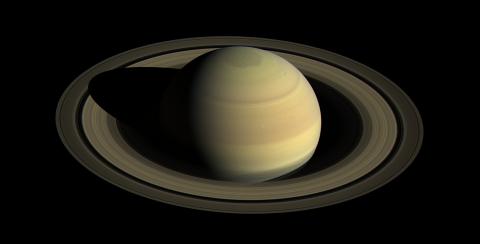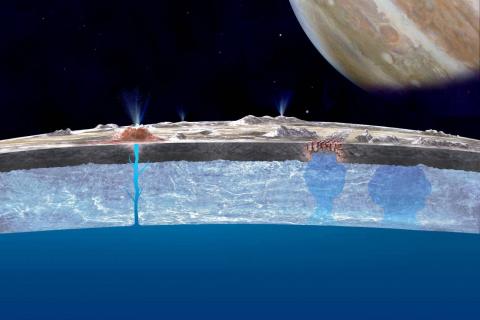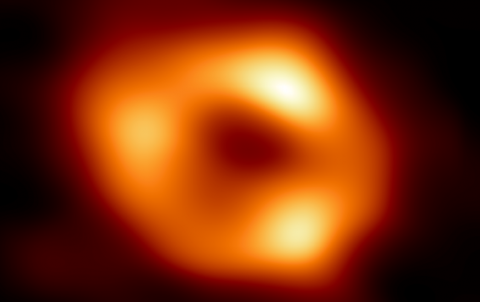Reactions to the first controlled asteroid impact
As planned, the DART (Double Asteroid Redirect Test) mission has hit the asteroid Dimorphos, which orbits a larger asteroid, Didymos. Neither is a threat to Earth. This is the first planetary defence test mission designed to change the orbit of an asteroid, launched by NASA and the Johns Hopkins APL laboratory, with Spanish participation. Scientific teams will study with ground-based telescopes how much the orbit of Dimorphos will change around Didymos after the collision.

Photograph of the asteroid Dimorphos taken by the DART mission moments before the collision. Author: NASA.
Jesús Martínez-Frías - impacto asteroide EN
Jesús Martínez Frías
Planetary geologist and astrobiologist at the IGEO (CSIC-UCM). Academician of the Royal Academies of Sciences and Doctors of Spain. President of the Planetary Geology Commission of the Geological Society of Spain and of the Spanish Network of Planetology and Astrobiology.
The study of nature and the universe has allowed us to advance enormously in our understanding of our environment, from the nanoscopic to the cosmological, and to establish a body of knowledge, of scientific culture, which has contributed to our progress and development as a species on our planet. But it has also allowed us to identify a series of risks and dangers that were unknown to us and went completely unnoticed. This has been the case, for example, with radioactivity, with the identification of the role of viruses or bacteria or, as in this case, with the discovery of the nearly 200 impact craters on our planet, those of the Moon and those of other planetary bodies in our solar system (Mercury, Mars, Europa, Ceres, Pluto, etc.).
In parallel to the discovery of all these "impactgenic structures" in the geological record, it has also been discovered that they are due to the arrival on Earth of large objects, which have contributed to the modification of environments, to drastic climatic changes and even to the extinction of certain species. This, together with the detection of millions of asteroids that accompany us in the so-called Near Earth Space, forces us to pay attention to this type of catastrophic events, which may pose a danger to humanity, and to try to be prepared in the event that an object - mainly an asteroid - is at risk of collision with the Earth.
It is in this context of planetary defence that NASA's DART mission, which has struck the Dimorphos asteroid to test whether the probe's collision with this object will succeed in deflecting it, even slightly, from its orbit, is framed. So far, there have been impact-related laboratory experiments, crater field studies and numerous computer simulations of scenarios representing different types of collisions. But this is the first time a mission has been conducted with the aim of deflecting the asteroid, not destroying it.
DART's target was a binary system that lies about 11 million kilometres from Earth. This system consists of the asteroid Didymos - about 780 metres in diameter - and Dimorphos - about 160 metres in diameter - which orbits the former primary object. The spacecraft, which had a speed of 23 000 km/h, hit Dimorphos to change its orbit within the binary system. The effect of the collision will provide crucial information to better understand how the deflection occurs, if it occurs at all. Another artificial satellite, LICIACube, is tasked with capturing images of the collision, the resulting crater and the cloud of ejected material.
We have witnessed a unique and fundamental astrophysical and astrogeological mission, which is of no danger to the Earth and of great importance for understanding how to act in the future should we find ourselves in a situation of risk and danger of asteroidal impact.
A few years ago I was the Spanish representative in the IMPACT programme of the European Science Foundation and author and scientific director of the High Level Technical Report for the current Department of National Security of the Presidency of the Government on this type of collision. I wish we could have had the data that, if all goes well, this mission will provide us with. A project of scientific and social importance for the whole of humanity that will help us to be prepared and to specify how to defend ourselves in the event that we might be exposed to such a danger in the future.
José María Madiedo - impacto asteroide EN
Jose María Madiedo Gil
Astrophysicist at the Instituto de Astrofísica de Andalucía (IAA-CSIC)
In the early hours of 26-27 September, at 1:14 local time, NASA's DART probe collided with the asteroid Dimorphos, a rock about 160 metres in diameter that revolves around a larger asteroid called Didymos, whose diameter is about 800 metres. The separation between the two celestial bodies is about 1 kilometre.
This is the first attempt to modify the trajectory of an asteroid in order to test a technology to protect the Earth from a possible future impact. This technology is known as "kinetic impact" and basically consists of deflecting an asteroid from its trajectory by causing a smaller object to collide with it. Of all the techniques that have been proposed to protect us from asteroid impacts, this is the simplest to implement with currently available technology.
Neither Dimorphos nor Didymos posed a danger to us before impact, as this binary system does not cross our planet's orbit. They continue to pose no risk to Earth after the collision of the DART probe, which has a mass of almost 600 kilograms, caused a small disturbance to Dimorphos' orbit. NASA has used Dimorphos as a laboratory in which to test this kinetic impact method, in order to compare the observed results with those predicted by theoretical models. This will allow us to refine these models and thus improve this technique so that it can be used in the future in case we have to deal with an object on a collision course with our planet.
The DART probe hit Dimorphos in the opposite direction of its motion, thus slightly reducing the speed of this asteroid and thus its radius of gyration around Didymos. Due to the gravitational interaction between the two rocks, the trajectory of Didymos has also changed slightly. The magnitude of these changes will be known in a few days (estimated to take about a week), when the effect of these changes will be noticeable.
On the other hand, the collision has generated a crater on the surface of Dimorphos, throwing into space some of the material excavated during the formation of this new crater and exposing "fresh" materials that were initially under the surface of the asteroid. The analysis of this crater and the materials inside it is a secondary objective of the mission.
The DART mission has thus been a major milestone in the field of planetary defence. Until now, our technology has allowed us to identify objects that are potentially dangerous for the Earth, thanks to our telescopes and the various sky-tracking programmes carried out by the various space agencies and other institutions. And it also allowed us to know whether these objects could pose a risk to us or not. But this space mission has been our first big step towards having the technology to avoid the enormous natural catastrophe that would be caused by the collision of a large celestial body with us.
Romano Corradi - impacto asteroide EN
Romano Corradi
Director of the Gran Telescopio Canarias (GTC)
Once again, this mission - remember the 2005 impact of the Deep Impact probe on comet 9P/Tempel 1? - highlights the power of our knowledge of (astro)dynamics, and physics in general, to pilot a probe to hit an asteroid of only 160 metres in diameter 11 million kilometres away from the Earth - it is like throwing a tiny stone and hitting another 1mm in size 69 km away - and we will see in the coming weeks whether it is confirmed that, as a result of the impact of the DART probe, the velocity of the asteroid Dimorphos has been reduced to the expected amount. We will see in the coming weeks whether it is confirmed that, as a result of the impact of the DART probe, the speed of the asteroid Dimorphos has been reduced by the amount predicted. Here too, the "astronomical" numbers are worth noting: DART weighs only 570 kg, but its high impact speed (24,000 km/hour) is capable of deflecting the trajectory of a small but appreciable amount, a mass of 5 billion kg.
This mission is a demonstration of a technique to free our planet from the possibility of a large asteroid impact. The question of whether asteroids are a real danger to our planet has no simple answer, because the effects depend on many factors, the main one being the size of the asteroid.
It is worth highlighting the unceasing work of ground-based telescopes all over the world, including those in Spain, which continuously scan the sky to detect and then track these dangerous objects (NEOs, or Near Earth Objects). These observations allow us to conclude that there are no asteroids larger than 1 km in size - capable of producing disasters on a global scale on our planet - that could hit the Earth in the next hundred years, but there remains the possibility that asteroids the size of Dimorphos could hit and produce disasters on a regional scale - the probability of them also hitting a densely inhabited area is, in any case, extremely small.
Is it worth investing so much effort and money for such a low-probability event? I believe that, given what is at stake, it is indeed necessary to continue studying the sky in search of potentially dangerous NEOs. But on the condition that we do not divert attention and effort from combating other threats to our ecosystem that are more certain, more serious and more urgent, such as climate change or the overexploitation of our (only) planet's resources.
He is a member of the advisory committee of SMC Spain.



